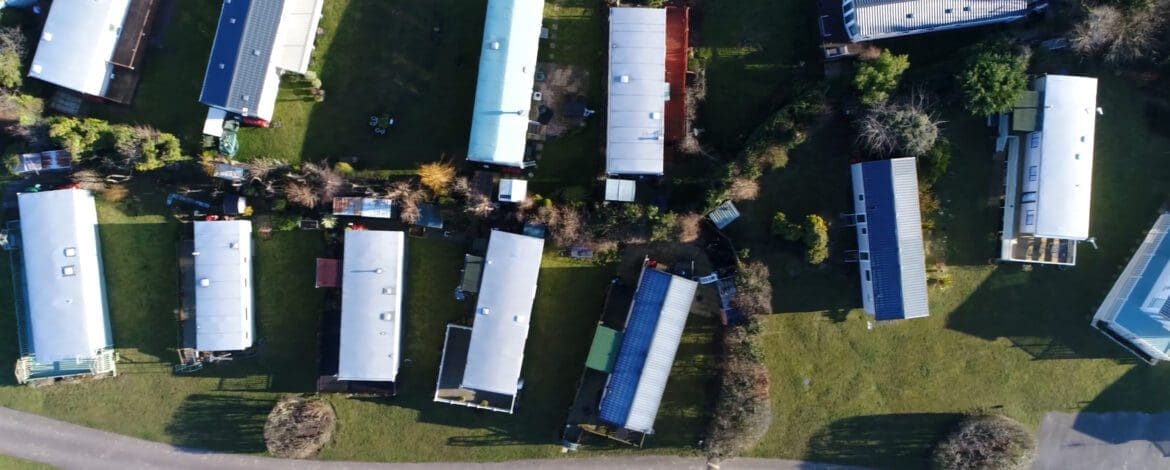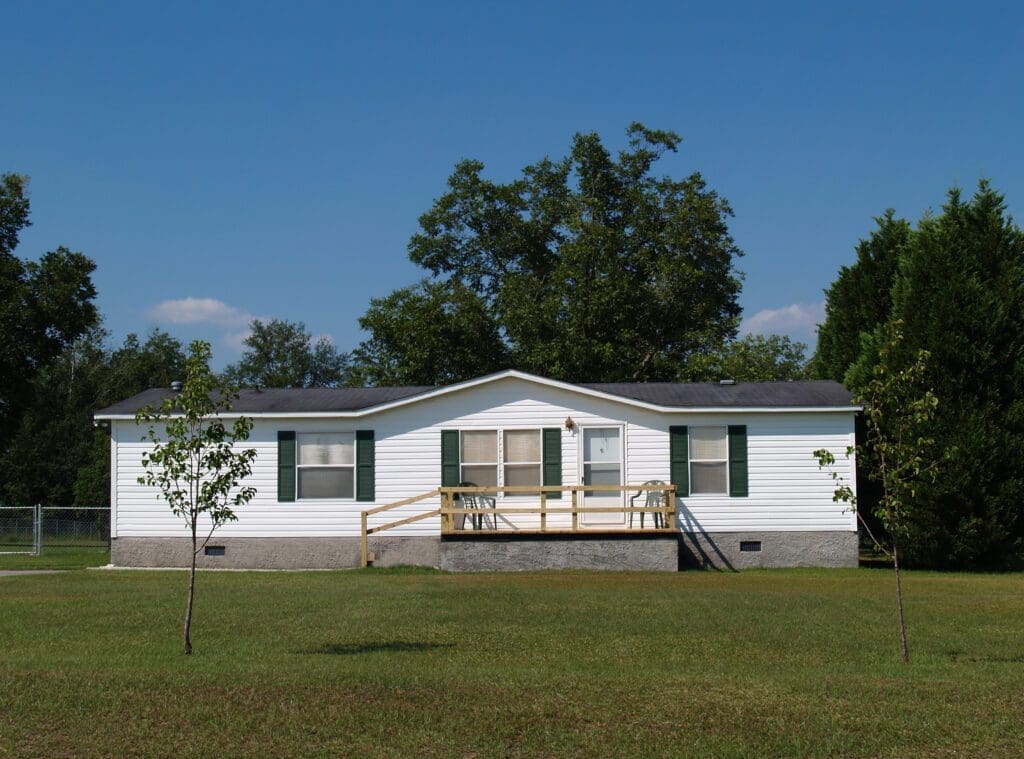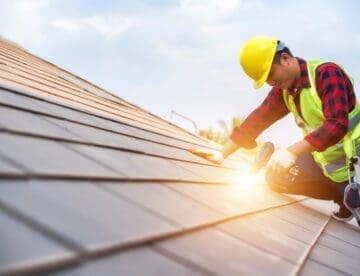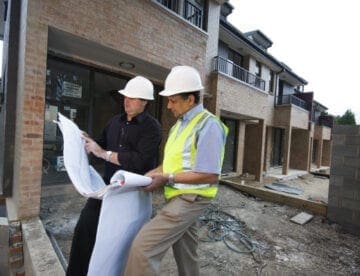Florida is well known for multiple types of housing, ranging from impressive to modest. From stylish Art-Deco structures in Miami to sprawling Mediterranean-style coastal estates to standard high-volume tract housing for families, you’ll find a variety all over Florida. Manufactured housing, though, is also popular and makes up close to 10% of Florida’s housing stock, providing affordable housing for many people who otherwise would never own a home. And naturally, those homes eventually need new roofs too. So what’s the cost for a manufactured home roof?
MANUFACTURED HOMES VS MODULAR HOMES
According to the US Census Bureau, there are more than 840,000 manufactured homes in Florida. Known to some folks as “mobile homes” in the past, this housing type has come a long way since the mid-1970s. That’s when the US Department of Housing and Urban Development (HUD) started regulating the industry to standardize how the units are built.
It’s common for people to confuse manufactured housing with modular housing, so let’s clear that up. In this article, we’ll be talking about manufactured housing, which is:
- Built in a factory with a steel frame that is a permanent part of the home. People often refer to this home type as a “single-wide” or “double-wide.”
- Trucked to the home site.
- Attached to a foundation at the site.
Single-wide manufactured homes are typically 66-80 feet long and 14-18 feet wide. A double-wide manufactured home is just two single wides made to be joined together on site. A double-wide looks little different from a basic one-story, site-built home these days.
In contrast, a modular home can be built from factory-built panels or from room modules, which are then delivered to the site and assembled there. Modular home components can be any size that can be delivered to the home site, so those homes usually appear more or less like a standard, site-built home.
Both contemporary manufactured and modular homes generally use standard materials and construction techniques, like site-built homes. They’re regulated and inspected somewhat differently, however.
Roof Options for Manufactured Homes
When it’s time for a new roof, you may have more than one option for your manufactured home. If the roof pitch is 3:12 or greater, you may have the option to use asphalt shingles or a metal roof. If the pitch is closer to flat, though, a membrane roof like TPO is what you’ll need. Let’s take a look at these and a couple of other options.
What About A “Roof-Over”?
First, for reasons of cost and convenience, many owners of manufactured homes consider what’s called a “roof-over.” This process is not unique to manufactured homes, but it is more prevalent with this home type. This basically means skipping the tear off of the old roof and installing the new materials directly over the old stuff. Why would you choose this option?
For one, you can save money with a roof-over, usually $1-$4 per square foot. It also keeps a substantial amount of waste out of landfills. According to Forbes, 12 million tons of asphalt shingles go to landfills each year. So far there really hasn’t been another option besides the landfill, so considering a roof-over has some appeal. Having an experienced contractor provide an opinion is what you’ll need for this. The old roof must be in fair to good condition for this option to work.
Another fairly common option is to build a peaked or gable roof on top of the existing flat roof. This project requires some expertise, but you end up with a steeper-pitched roof that looks more like the roof on a site-built home. Then you can install asphalt shingles or a metal roof, as we’ll discuss further on. It’s good to know your options!
Flat or Membrane Roofing for Manufactured Homes
Most manufactured homes with a flat or slightly rounded roof, known as a “bowstring” roof, originally had a membrane roof factory installed. TPO (thermoplastic polyolefin) is the newest material for this type of roof. It’s now used commonly on manufactured homes, commercial buildings, and any other structure with a flat or nearly flat roof. TPO works so well for several reasons. Its white color is reflective, so it keeps the sun’s rays from heating up your house in the summer.
It’s also installed as one sheet, eliminating all seams for maximum leak protection. Around penetrations like skylights and vents, the boots for those items are heat welded to the membrane. There’s no glue to fail over time, and no screws to leak. It’s a very slick system that should last 10-15 years, if you get a high-quality installation.
The best way to a high-quality and long-lasting TPO roof involves tearing off the old roofing. However, it’s fairly common to put the new roofing material over the old roof, if the old roof is in acceptable condition. This is a judgment call for your contractor, but this approach does save money.
How much? A new TPO roof going for $4.50–$14 per square foot, including installation. Adding exterior rigid insulation is a no-brainer, in our opinion, and that’s $1.50–$3.50 per square foot installed. Tear off runs $1–$4 per square foot, so if you can skip that cost, sometimes it makes sense. Again, it’s a judgment call based on a thorough evaluation of the existing roof material.
Asphalt Shingles for Manufactured Homes
Asphalt shingles are overwhelmingly the most-common roofing material in the US. They’re easy to work with, go on quickly, and are budget friendly. They do, however, require at least a 2:12 roof pitch. Quite a few newer manufactured homes meet this requirement, meaning you can choose this simple, tried-and-true option.
You’ll have to sort through a couple options, though. You’ll pay the least for basic three-tab asphalt shingles, but they have one serious drawback: they’re usually rated to wind speeds of only 60 mph. In contrast, you’ll get a 120-mph rating or better from upgraded architectural shingles.
The better, heftier architectural shingles will probably cost about 50% more, but could last twice as long. With essentially the same labor cost between the two options, the architectural shingles are a better value, as long as that option suits your budget. You’ll pay around $3.50 per square foot, installed.
As for tear off, you’ll probably have to do this. Another layer of shingles could easily overload your roof framing, unless you upgrade the framing. That can also be a hefty cost in itself.
Metal Roofing for Manufactured Homes
If your home’s roof has enough pitch, you can consider a metal roof. The most-common type is a screw-down steel roof. These are simple to install, wind resistant, reflective, and light in weight. You might be able to skip the tear off, too, which saves money and landfill space. A new metal roof also makes it easy to add exterior rigid insulation, which will help keep your home cooler. That insulation will also pay for itself in a few years, too, with reduced load on the air conditioner.
The most-common type of painted steel roofing will start at about $5.50 per square foot. Nicer standing-seam roofing, which uses hidden screws, will be closer to $10 per square foot. Both are solid choices for your new roof and should be at least a 20-year roof.
We’re Here When You Need Us
That’s a lot of options to consider, for sure, but we’re here to help. If you’d like to talk about replacing your roof on your manufactured home, give us a call at 813-373-9088. Our team has more than 40 years of experience in roofing. You can also use this form and ask us, “what’s the cost to replace my roof?” and we will contact you.
CLICK HERE FOR AN INSTANT ONLINE QUOTE IN 60 SECONDS
clear





